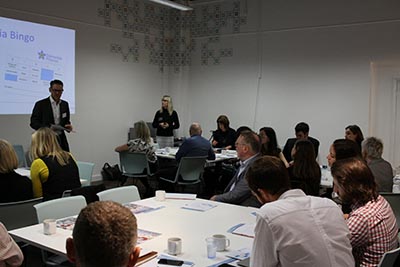KTN ran a symposium in December 2015 looking at the issues faced by people with Alzheimer’s disease or dementia, with a view to identifying ways in which materials innovation (and design innovation in general) can improve matters.
KTN Director Iain McGregor introduced the day, encouraging delegates to use the opportunity to help look for ideas that can help to enrich the lives of people with dementia. An introductory video was then shown, which had been made especially for KTN by BBC presenter Angela Rippon, who is also an ambassador for the Alzheimer’s Society. Rippon explained how nobody wishes to hinder creativity but that designers need to try to consider the requirements of people with dementia, so that great designs are usable by more people with different needs.

Next to speak was Colum Lowe, founder of the design consultancy BEING. Lowe is also a ‘dementia friend’, part of a programme run by the Alzheimer’s Society that informs people about dementia as well as the numerous ways in which they can provide support. He explained how the emotional and sensory side of life becomes more important for those with dementia. Such stimulation can help those with dementia to focus — a point demonstrated by a short video showing how music palpably helps an elderly man with dementia regain parts of his memory and hugely boosts his ability to interact and engage with those around him.
KTN knowledge transfer managers Sarah Forson, John Bound and Barry Waddilove (from the areas of health, materials and design respectively), provided further context and elaborated upon ways in which design could potentially help those with dementia.
Complementing this were talks by Anke Jacob from Kingston University and Sarah Jones from Arup. Jacob explained how the requirements and capabilities of people change as dementia develops. At advanced stages of dementia, sufferers should be given activities that focus almost wholly on the sensory parts of activities. Taking all this into account, designers should try to design things with a feeling of familiarity that are stimulating yet remain relaxing and comforting. Jones elaborated on this by providing examples of good and bad design for people with dementia, and how good use of space, lighting and contrast can provide attractive spaces that are usable by more members of society.
Madeleine Starr from Carers UK told a personal story about her father’s struggle with vascular dementia. Carers UK has developed an app called Jointly, which is designed to make the process of co-ordinating the care of people far easier. Starr stated the importance of involving carers in the process of product and service design.
The above talks were followed by a materials and design showcase featuring:
• Paul Rodgers — Professor in Design Issues at Northumbria University
• Tatiana Correia — Knowledge Transfer Manager for Nanotechnology at KTN
• Anava Baruch — Managing Director and Clinical Lead at Design for Independence
• Freddie Yauner — Co-founder and Creative Director of Shift.ms
• John Ziesel — President and Co-founder of Hearthstone Alzheimer Care
A workshop followed, with groups made up of people from differing backgrounds brainstorming to try to meet certain challenges. Ideas were recorded to inform future KTN activity in this area, before the day was closed by Jackie Marshall-Cyrus, Lead Specialist — Assisted Living Innovation Platform at Innovate UK. Marshall-Cyrus challenged delegates to try to consider some of the more taboo issues that can affect those with later-stage dementia, such as hyper sexuality and other behavioural changes.